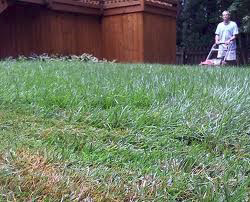
This has been a tough year for lawn grass in Lafayette Parish and South Louisiana. I received numerous calls from homeowners concerned about the poor performance of their lawns, especially St. Augustine and Centipede grass. Upon evaluation of these lawns, I found many that had areas with two to three inches of thatch. Thatch is an accumulation of organic matter, primarily dead leaves and stems that cause serious problems in lawns. If a lawn feels spongy when walked upon, that often suggests a thatch problem. Thatch accumulates when organic matter accumulates faster than it can decompose. The roots of the lawn grass will grow into the thatch which can lead to an increase of insect and disease problems. The reason why many of the St. Augustine and Centipede lawns struggled this growing season relates to the unusually cold winter and cold injury because roots growing in the thatch were more susceptible to cold injury than the roots that would have been growing in soil. A thatch problem in a lawn has to be addressed by dethatching with either a motorized thatching machine or a dethatching rake. Removing thatch should be done in early to mid-April to allow an application of fertilizer. Removing thatch shocks the grass, so a fertilizer application is recommended in order to help the lawn grass to recover. The final issue with thatch is that it remains wet when rain comes frequently, but when the thatch dries it gets extremely dry. Neither situation is good for lawn grass.
One of the most common diseases of warm season turf grasses in Louisiana is Large Patch (also called Brown Patch). Every growing season, I get numerous calls from concerned gardeners regarding dead areas in their lawns. Brown Patch disease primarily occurs when night time temperatures begin to consistently drop below 70 degrees — in the fall, late winter and early spring. Since moisture also promotes Brown Patch activity, periods of rain make the disease spread rapidly. While brown patch can affect all warm season lawn grasses, it is usually more prevalent in St. Augustine lawns. The symptoms usually begin as a small irregular patches of brown areas in the lawn. With mild temperatures and rainfall these areas can enlarge rapidly. Once these areas of the grass are weakened and thinned by brown patch, weeds begin to invade. If a lawn has a history of brown patch disease, a couple of fall applications of fungicide can limit the impact of Brown Patch. Once conditions favor disease development, it is recommended that fungicide applications begin. For this area, that first application should be made between mid and late September, followed by a second application mid to late October. If conditions remain favorable for disease development into November and December, additional fungicide applications may be necessary. Since many fungicides labeled for lawns will have activity on brown patch, homeowners should be able to find these fungicides at retail nurseries and garden centers as well as feed and seed stores. According to Dr. Ron Strahan, Lawn & Turf Specialist with the LSU AgCenter, the two most effective fungicides for addressing brown patch problems in lawns are fungicides containing azoxystrobin or thiophanate methyl. If brown patch is not visible and the homeowner wants to be proactive, then granular fungicides are recommended. If however brown patch has already been identified in the lawn, the liquid fungicides applied as a spray are most effective. If we have a mild winter where the lawn does not go fully dormant, it is possible that brown patch will be present throughout the winter months and into the spring. If that happens, then homeowners may want to consider applying several applications of fungicides through winter and into the spring.
Finally, I am also getting calls from homeowners who are asking for fertilizer recommendations for their St. Augustine lawns. According to Dr. Strahan, St. Augustine responds to three applications of fertilizer annually: in mid-April , mid –June and Mid- August. In my opinion, it is now too late to fertilize St. Augustine lawns. Fertilizing now, especially with a fertilizer containing nitrogen, can aggravate brown patch disease. It can delay dormancy which could make St. Augustine lawns more susceptible to cold injury. There are fertilizers available called winterizing fertilizers that can be applied in fall, but here in South Louisiana if a homeowner decides to apply a winterizing fertilizer, it should not contain any nitrogen (N), it should contain primarily potassium (K).
Happy Gardening!!!Happy Gardening!!!Gerald P. Roberts

 RSS Feed
RSS Feed